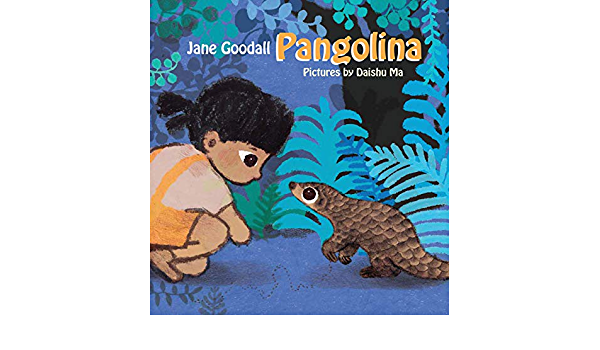Pangolina is my favorite Disney Princess. No, actually Pangolin is the commonly referred to name of Pholidota, the scaley-backed creature that looks like a small dinosaur with a really long tongue. When they get scared they curl up into a ball, resembling a massive Roly-Poly, rather than the world’s most trafficked animal. Pangolina, in this case, is also an illustrated book that manages to introduce young readers to this erstwhile mammal. What kids, as well as adults, will enjoy about the book is that it tells a story, has beautiful art, and the stamp of approval from Jane Goodall.

Jane Goodall is also the author of Pangolina. Of course, Goodall is much more than that and has dedicated her life to wildlife conservation in addition to publishing lots of books for adults and children. This book isn’t a case of a celebrity who merely wrote something to cash in on the fact that people know who they are. Much like Ric Flair, she walks the walk and talks the talk. If nature conservation involved any degree of staged confrontation or conflict then Goodall could easily say “In order to be the woman, you’ve got to beat the woman”.
In Pangolina, readers are following along with our titular character as she learns the ropes. Her mom is eating termites and showing her where to find them. She’s introducing her to the other critters in the forest and meets a curious two-legged animal who’s the baby of a ‘dangerous’ creature. This two-legged creature is called off by their mom and has to go home shortly after they meet.
A couple of days later, the pangolins are resting underground when a new, unfamiliar foe enters their world. They hear loud barking and then see a stick being pushed into their burrow by a gloved hand. Pangolina is stuffed into a cloth bag, where two of her other friends tell their confused friends what’s happening. One of her friends, Civat, explains that the human is going to kill and eat them, while they would have their scales pulled off and used for medicine that they think works.
Wow. The way that scene is broken down in the book is powerful, true, age-appropriate, and frustrating. It’s educational to those audiences that hadn’t heard about it before and adds another dimension of ager to those who have. The animals go on to say that the human doesn’t mean to be cruel, but that they’re just trying to feed their family. While some older readers might disagree with that assessment, it does add an element of relatability to younger readers who question why and how something like this can happen.
The next scene is a wet market where umpteen cages are alluded to, with each one containing a live animal that’s due to be sold. Thankfully, Ai, the girl from the jungle sees the scene, alerts the police to what’s happening, and takes Pangolina to a sanctuary.
First off, the book does tell a sad, tragic story about what happens in certain parts of the world to wildlife. However, it does so in a way that’s age-appropriate, without watering down the content or making it unrealistic. This is an illustrated book that will work with kids aged five and up. Those younger kids won’t be able to read it, but the content and its presentation is A-OK for them.
It’s also a great good-night book. The text is big and consists of mainly simple sentences, yet at the same time telling a story from start to finish. What’s more, the story could easy be very complex and lead to questions about morality, animal care, or cultural differences, just to name a few.
The art is by Daishu Ma and compliments the story in the text very well. The illustrations are presented in a folk, textured manner that stand out nicely against the background. The people in the book are presented in a similar fashion, but are just a bit more vague. This is the animal’s book and the fact that they have front stage make perfect sense.
Pangolina is also not preachy or designed to evoke guilt in any way. There’s an implied lack of common sense or stupidity in the humans who use their scales for medicine that’s not proven to work, but the book takes the high road. The book from the shark’s viewpoint about the use of their fins would not be so kind.
The final couple of pages provide a more encyclopedic look at pangolins, their behavior, where you can see them, and websites for more information. There are also two pages dedicated to Goodall’s main website and the Roots and Shoots organization, which is something upper-elementary ages would really enjoy.
Pangolina is by Jane Goodall with pictures by Daishu Ma and on Minedition.
There are affiliate links in this post.




 Facebook
Facebook Twitter
Twitter Flickr
Flickr GooglePlus
GooglePlus Youtube
Youtube